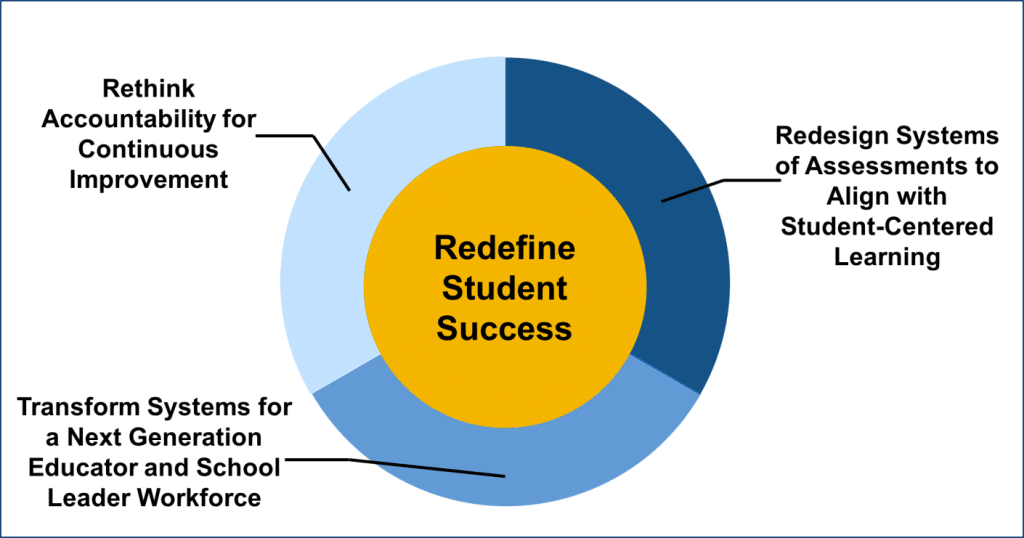Issue to Tackle for Certifying Learning: Redefining Student Success
Education Domain Blog

Moving to a future state of an equitable K-12 education system requires that we consider and perhaps rethink what students need to know and be able to do to achieve success. It also requires that we set a vision and foundation for achieving success throughout the state education system.
Here we dig into the second issue to tackle related to certifying learning: broadening the definition of student success. This post builds off previous blogs in a series related to our publication, Fit for Purpose: Taking the Long View on Systems Change and Policy to Support Competency Education.
How can the high school diploma align to a more comprehensive definition of success?
There are design flaws in our current system that are often absent from current debates. A common concept emerging in global education systems is the term “curriculum redesign,” which is fundamentally asking the question, “What do our students need to know and be able to do?” — especially with respect to a more holistic notion of student success for the future. Whether a community conversation or a state conversation, the idea of engaging communities and families in conversations around what is different and around what students need to know and be able to do, is increasingly important.
How could we think differently about a broader set of outcomes? These outcomes would consider academic knowledge and skills, and competencies such as learning how to learn, lifelong learning (which includes how to set goals personally, academically, professionally and attain them), social emotional skills, empathy, compassion and cultural responsiveness. Lastly, it includes navigating an increasingly complex world with problem-solving, communication and self-efficacy skills to actively engage in civil society and democracy.
The curriculum redesign process asks: “What should students learn to succeed in the 21st century?” From Asia to Europe, from Australia and New Zealand, to Africa and India and across the provinces of Canada, there is a deep and complex debate in communities around what students need to know and be able to do. In contrast, conversations in policy in the United States occur largely around standards and graduation requirements. However, they are based on limited definitions of success centered around content proficiency. States can begin to engage districts and communities around what students need to master for true preparedness, and the implications for rethinking outdated accountability models.
We need to think about redesigning education with new models of active, inquiry-based pedagogy to move forward with more holistic, learner-centered, competency-based learning models that help students gain the knowledge and skills they need to thrive after high school graduation. Once local communities have a shared understanding of what student success looks like, they can drive state-level understanding of curriculum redesign and the implications for new accountability models, new designs for assessments and new school models. They can also work on building systems capacity (and greater coherence).
An important concept for policymakers to consider, as they identify their theory of action for driving changes to the systems surrounding curriculum, instruction and assessment, is how to redefine success and how it could be used to drive system coherence. In countries with high-performing education systems, “curriculum” is a broader concept that encompasses much more than academic content standards. It reflects knowledge and skills in higher order thinking, academics and lifelong learning. Curriculum may also be linked to qualifications frameworks, which define the competencies necessary for success in career pathways.
Through redefining success, everyone — students, parents, educators and policymakers — can understand what students should know and be able to do upon graduation. District and community stakeholders can be engaged in conversations on outcomes for student learning. A statewide vision and mission for student success can create alignment and coherence between state education systems and support the shift to competency-based education models that ensure all students graduate ready to succeed during and beyond K-12 education.
Learn more about redefining student success in the paper Fit for Purpose: Taking the Long View on Systems Change and Policy to Support Competency Education.
Follow this blog series for more key insights:
- Fit for Purpose: Taking the Long View on Systems Change and Policy to Support Competency Education
- Threshold Concept: Certifying Learning to Ensure Student Success and Career Pathways
- Issue to Tackle for Certifying Learning: Meaningful Qualifications
Learn more:
- Report: Fit for Purpose: Taking the Long View on Systems Change and Policy to Support Competency Education
- Report: Current to Future State: Issues and Action Steps for State Policy to Support Personalized, Competency-Based Learning
- Issue Brief: Redefining Student Success: Profile of a Graduate
- Issue Brief: Redesigning Systems of Assessments for Student-Centered Learning
- Issue Brief: Rethinking State Accountability to Support Personalized, Competency-Based Learning in K-12 Education
- Issue Brief: State Strategies to Develop Teacher Capacity for Personalized, Competency-Based Learning
- Issue Brief: State Policy & K-12 Competency-Based Education
- Blog: Assessment Literacy to Support Competency-based Education Systems and other Deeper Learning Efforts
- Report: Not as Easy as it Sounds: Designing a Balanced Assessment System
- Assessment for Learning Project
- Blog: How States Can Transform Systems of Assessments to Support Teachers and Students
- National Summit on K-12 Competency-Based Education
Join the conversation:
- Follow us on Twitter: @nacol, @SusanDPatrick, @mariaworthen, @DaleKFrost, @ntruongedu
